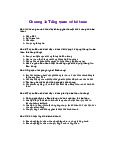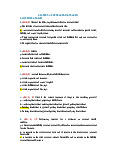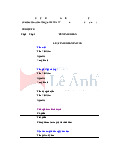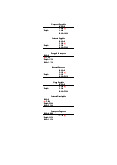



















Preview text:
CHAPTER 1 - ACCOUNTING IN ACTION
Lecturer: DINH THANH LAN
1. (LO 1) K The main objective of the financial statements is to provide useful information to
a. government in deciding if the company is respecting tax laws
b. increase the value of the company
c. investors and creditors that is useful when they are making decisions about the business
d. management that is useful when they are making decisions about the business
2. (LO 1) K Which of the following statements about users of accounting information is incorrect?
a. Management is an internal user.
b. Taxing authorities are external users.
c. Present creditors are external users.
d. Regulatory authorities are internal users.
3. (LO 2) K The three types of business organization forms are:
a. proprietorships, small businesses, and partnerships.
b. proprietorships, partnerships, and corporations.
c. proprietorships, partnerships, and large businesses.
d. financial, manufacturing, and service companies Instructions
a. In part 1, identify the users as being either external users (E) or internal users (I).
b. In part 2, identify each of the questions as being more likely asked by an internal user (I) or an external user (E).
CHAPTER 2: ACCOUNTING EQUATION AND TRANSACTION ANALYSIS
(PHƯƠNG TRÌNH KẾ TOÁN VÀ PHÂN TÍCH GIAO DỊCH) QUIZES:
7. (LO 4) AP As at December 31, at it’s year end, Bruske Company has assets of $12,500;
revenues of $10,000; expenses of $5,500; beginning owner’s capital of $8,000; and drawings of
$1,500. What are the liabilities for Bruske Company as at December 31? a. $1,500 b. $2,500 c. $500 d. $3,500
8. (LO 5) AP Performing services on account will have the following effects on the components
of the basic accounting equation:
a. increase assets and decrease owner’s equity.
b. increase assets and increase owner’s equity.
c. increase assets and increase liabilities.
d. increase liabilities and increase owner’s equity.
9. (LO 5) AP Bing Company pays $700 for store rent for the month. The basic analysis of this
transaction on the accounting records is:
a. the asset Cash is increased by $700 and the expense Rent Expense is increased by $700.
b. the asset Cash is decreased by $700 and the expense Rent Expense is increased by $700.
c. the asset Cash is decreased by $700 and the liability Rent Payable is increased by $700.
d. the asset Cash is increased by $700 and the liability Rent Payable is decreased by $700
BE1.9 (LO 4) AP Use the accounting equation to answer each of the following questions:
a. The liabilities of Weber Company are $120,000 and the owner’s equity is $232,000. What is
the amount of Weber Company’s total assets?
b. The total assets of King Company are $190,000 and its owner’s equity is $91,000. What is the
amount of its total liabilities?
c. The total assets of Smith Company are $800,000 and its liabilities are equal to one half of its
total assets. What is the amount of Smith Company’s owner’s equity?
BE1.10 (LO 4) AP Butler Company is owned by Rachel Butler. The company had total assets of
$850,000 and total liabilities of $550,000 at the beginning of the year. Answer each of the
following independent questions:
a. During the year, total assets increased by $130,000 and total liabilities decreased by $80,000.
What is the amount of owner’s equity at the end of the year?
b. Total liabilities decreased by $95,000 during the year. The company incurred a loss of
$40,000. R. Butler made an additional investment of $100,000 and made no withdrawals. What
is the amount of total assets at the end of the year?
c. Total assets increased by $45,000 and total liabilities decreased by $50,000. There were no
additional owner’s investments, and R. Butler withdrew $40,000. What is the amount of profit or loss for the year?
BE1.11 (LO 4) K Indicate whether each of the following items is an asset (A), liability (L), or
part of owner’s equity (OE).
_______ 1. Accounts receivable _______ 4. Supplies
_______ 2. Salaries payable __ _____ 5. Owner’s capital
_______ 3. Equipment __ _____ 6. Notes payable
BE1.14 (LO 4, 5) AP Classify each of the following items as owner’s investments (I), drawings
(D), revenue (R), expenses (E), or as having no effect on owner’s equity (NE):
a. _______ Advertising expense
b. _______ Commission fees earned
c. _______ Cash received from the company’s owner
d. _______ Amounts paid to employees
e. _______ Services performed on account
f. _______ Utilities incurred
g. _______ Cash distributed to company owner
BE1.12 (LO 5) AP Presented below are eight business transactions. Indicate whether the
transactions increased (+), decreased (-), or had no effect (NE) on each element of the accounting equation.
a. Purchased $250 of supplies on account.
b. Performed $500 of services on account.
c. Paid $300 of operating expenses.
d. Paid $250 cash on account for the supplies purchased in item (a) above.
e. Invested $1,000 cash in the business.
f. Owner withdrew $400 cash.
g. Hired an employee to start working the following month.
h. Received $500 from a customer who had been billed previously in item (b) above.
i. Purchased $450 of equipment in exchange for a note payable.
E1.12 (LO 5) AP At the beginning of March, Brister Software Company had Cash of $12,000,
Accounts Receivable of $18,000, Accounts Payable of $4,000, and G. Brister, Capital of 26,000.
During the month of March, the following transactions occurred:
1. Purchased equipment for $23,000 from Digital Equipment. Paid $3,000 cash and signed a note payable for the balance.
2. Received $12,000 from customers for contracts billed in February.
3. Paid $3,000 for March rent of office space.
4. Paid $2,500 of the amounts owing to suppliers at the beginning of March.
5. Provided software services to Kwon Construction Company for $7,000 cash.
6. Paid BC Hydro $1,000 for energy used in March.
7. G. Brister withdrew $5,000 cash from the business.
8. Paid Digital Equipment $2,100 on account of the note payable issued for the equipment
purchased in transaction 1. Of this, $100 was for interest expense.
9. Hired an employee to start working in April.
10. Incurred advertising expense on account for March, $1,500. Instructions
Prepare a tabular analysis of the above transactions. The first row contains the amounts the
company had at the beginning of March.
P1.6A (LO 4, 5, 6) AP Frank Petronick decided to start an accounting practice after graduation
from university. The following is a list of events that occurred concerning Frank’s practice
during June 2021, the first month of operations:
1 After shopping around, Frank found an office to lease and signed a lease agreement. The lease
calls for a payment of $1,050 rent per month.
4 Borrowed $3,846 from his grandmother so that he could buy some office furniture for his new office.
4 Deposited the $3,846 plus $530 of his own cash in a new bank account at BMO under the
name Petronick Accounting Services.
6 Paid the landlord the f rst month’s rent.
8 Purchased furniture for $3,160 on account.
11 Moved into the office and obtained the first assignment from a client to prepare year-end
financial statements for $1,865.
15 Performed the work on the assignment and sent an invoice to the customer for $1,865.
15 Paid half of the amount of the purchase of furniture.
18 Purchased supplies on account for $344.
26 Paid for Internet services, $49 cash.
28 Collected $900 of the June 15 billing to the customer.
30 Withdrew cash from the business of $128 for personal expenses. Instructions
a. Prepare a tabular analysis of the effects of the above transactions on the accounting equation.
b. From an analysis of the owner’s equity, calculate the account balance in F. Petronick, Capital, at June 30.
P1.7A (LO 3, 4, 5, 6) AP The following events concern Anita LeTourneau, a Manitoba law
school graduate, for March 2021:
1. On March 4, she spent $20 on a lottery ticket.
2. On March 7, she won $250,000 in the lottery and immediately quit her job as a junior lawyer
3. On March 10, she decided to open her own law practice, and deposited $50,000 of her
winnings in a business chequing account, LeTourneau Legal Services.
4. On March 14, she purchased a new luxury condominium with a down payment of $150,000
from her personal funds plus a home mortgage of $200,000.
5. On March 15, Anita signed a rental agreement for her law office space for $2,500 a month,
starting March 15. She paid the first month’s rent, as it is due on the 15th of each month.
6. On March 19, she hired a receptionist. He will be paid $500 a week and will begin working on March 24.
7. On March 20, she purchased equipment for her law practice from a company that had just
declared bankruptcy. The equipment was worth at least $15,000 but Anita was able to buy it for only $10,000.
8. On March 21, she purchased $400 of supplies on account.
9. On March 24, she purchased an additional $6,500 of equipment for her law practice for $3,000
plus a $3,500 note payable due in six months.
10. On March 31, she performed $3,500 of legal services on account.
11. On March 31, she received $2,500 cash for legal services to be provided in April.
12. On March 31, she paid her receptionist $500 for the week.
13. On March 31, she paid $400 for the supplies purchased on account on March 21. Instructions
a. Prepare a tabular analysis of the effects of the above transactions on the accounting equation.
b. Calculate profit and owner’s equity for the month ended March 31.
P1.8A (LO 4, 5, 6) AP Izabela Jach opened a medical office under the name Izabela Jach, MD, on August 1, 2021.
* On August 31, the balance sheet showed Cash $3,000; Accounts Receivable $1,500; Supplies
$600; Equipment $7,500; Accounts Payable $5,500; Note Payable $3,000; and I. Jach, Capital, $4,100.
* During September, the following transactions occurred:
4 Collected $800 of accounts receivable.
5 Provided services of $10,500, of which $7,700 was collected from patients and the remainder was on account.
7 Paid $2,900 on accounts payable.
12 Purchased additional equipment for $2,300, paying $800 cash and leaving the balance on account.
15 Paid salaries, $2,800; rent for September, $1,900; and advertising expenses, $275.
18 Collected the balance of the accounts receivable from August 31.
20 Withdrew $1,000 for personal use.
26 Borrowed $3,000 from the Bank of Montreal on a note payable.
28 Signed a contract to provide medical services, not covered under the government health
plan, to employees of CRS Corp. in October for $5,700. CRS Corp. will pay the amount
owing after the medical services have been provided.
29 Received the telephone bill for September, $325.
30 Billed the government $10,000 for services provided to patients in September.
Instructions: Beginning with the August 31 balances, prepare a tabular analysis of the effects of
the September transactions on the accounting equation.
P1.6B (LO 4, 5, 6) AP Kensington Bike Repair Shop was started on April 1 by L. Depres. A
summary of the April transactions follows:
1 Invested $21,000 to start the repair shop.
2 Purchased equipment for $9,000, paying $3,000 cash and signing a note payable for the balance.
5 Paid rent for the month, $1,050.
7 Purchased $975 of supplies on account.
9 Received $3,200 in cash from customers for repair services.
16 Provided repair services on account to customers, $2,900.
26 Collected $1,200 on account for services billed on April 16.
27 Paid for supplies purchased on April 7. 28 Paid $290 for advertising.
29 Withdrew $1,300 for personal use.
30 Received April utility bill, $200.
30 Paid part-time employee salaries, $1,400.
30 Billed a customer $750 for repair services.
30 Received an advance from a customer for repairs to be performed in May, $2,100. Instructions
a. Prepare a tabular analysis of the effects of the above transactions on the accounting equation.
b. From an analysis of the owner’s equity, calculate the account balance in L. Depres, Capital at April 30.
P1.7B (LO 3, 4, 5, 6) AP Lynn Barry started her own consulting firm, Barry Consulting, on June
1, 2021. The following transactions occurred during the month of June:
1. Sold her shares in Big Country Airlines for $7,000, which she deposited in her personal bank account.
1. Transferred $6,000 from her personal account to a business account in the name of Barry Consulting
2. Paid $900 for office rent for the month.
3 .Purchased $545 of supplies on account.
5. Paid $95 to advertise in the County News.
9 .Received $3,275 for services provided.
12. Withdrew $600 for personal use.
15. Performed $5,000 of services on account.
17 .Paid $1,800 for employee salaries.
21. Received $3,000 for services provided on account on June 15.
22. Paid for the supplies purchased on account on June 3.
25. Signed a contract to provide consulting services to a client for $5,500. Services will be
performed and paid for in July.
26 .Borrowed $5,500 from the bank and signed a note payable.
29 .Used part of the cash borrowed from the bank on June 26 to purchase equipment for $2,150.
30 .Paid $150 for telephone service for the month.
30. Received $2,500 from client for consulting to be provided in July. Instructions
a. Prepare a tabular analysis of the effects of the above transactions on the accounting equation.
b. Calculate profit and owner’s equity for the month ended June 30.
c. Prepare a balance sheet at June 30.
P1.8B (LO 4, 5, 6) AP Fraser Baker opened Baker’s Accounting Service in Winnipeg on September 1, 2021.
*On September 30, the balance sheet showed Cash $5,700; Accounts Receivable $2,100;
Supplies $350; Equipment $7,600; Accounts Payable $4,300; and F. Baker, Capital $11,450.
*During October, the following transactions occurred:
1 Paid $3,800 of the accounts payable. 1 Paid $900 rent for October.
4 Collected $1,550 of the accounts receivable.
5 Hired a part-time ofce assistant at $80 per day to start work the following week.
8 Purchased additional equipment for $4,000, paying $500 cash and signing a note payable for the balance.
14 Performed $900 of accounting services on account. 15 Paid $300 for advertising.
18 Collected $400 from customers who received services on October 14.
20 Paid $500 for family dinner celebrating Fraser’s son’s university graduation.
25 Borrowed $8,000 from the Manitoba Bank on a note payable.
26 Sent a statement reminding a customer that he still owed the company money from September.
28 Earned revenue of $5,400, of which $3,100 was paid in cash and the balance was due in November.
29 Paid the part-time office assistant $720 for working nine days in October.
29 Received $2,800 cash for accounting services to be performed in November.
30 Received the telephone bill for the month, $205.
30 Withdrew $1,200 cash for personal expenses. Instructions:
Beginning with the September 30 balances, prepare a tabular analysis of the effects of the
October transactions on the accounting equation.
CHAPTER 3 – FINANCIAL STATEMENT (BÁO CÁO TÀI CHÍNH)
E1.8 (LO 5) C Below are some items found in the financial statements of Petra Zizler, Orthodontist. (a) (b)
1. Accounts payable _______ _______
2. Accounts receivable _______ _______ 3. Cash _______ ______
4. Equipment _______ _______
5. Interest payable _______ _______
6. Interest revenue _______ _______
7. Interest expense _______ _______
8. Investment by the owner _______ _______
9. Service revenue _______ _______
10. Prepaid rent _______ _______
11. P. Zizler, capital (opening balance) _______ _______
12. P. Zizler, drawings _______ _______
13. Salaries expense _______ _______
14. Supplies _______ _______
15. Supplies expense _______ _______
16. Unearned revenue _______ _______ Instructions Indicate:
a. whether each of the above items is an asset (A), liability (L), or part of owner’s equity (Eq); and
b. which financial statement—income statement (IS), statement of owner’s equity (OE), or
balance sheet (BS)—it would be reported on. The first one has been done for you as an example.




